‘TV Game System Having Reduced Memory Needs’
A Lengthy Tour of NES Patents
If you’ve ever seen a Famicom alongside an NES, you might be shocked that they’re the same system. The NES’s older Japanese sibling is a diminutive red and white plastic box with hardwired controllers and a top-loading cartridge slot. It’s nothing like the muted black, white, and gray ‘toaster’ that millions of Americans brought into their homes. The NES is more VCR than child’s toy — a clever Trojan horse that helped Nintendo dominate the American console market.
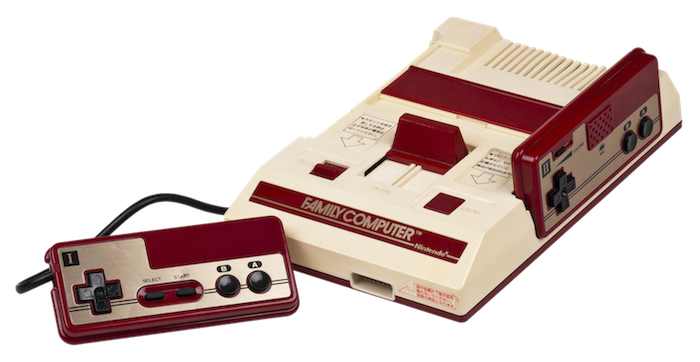
Nintendo’s flagship store in New York City has a modest glass-cased ‘museum’ on display with several notable items, from a charred Game Boy that survived the first Gulf War to a bevy of Club Nintendo rewards. Yet there’s one oddball item that looks like a cross between the NES and an early computer — the Advanced Video System. It was the first prototype of the American Famicom, shown to potential electronics distributors to drum up support for a stateside launch. It’s slick 80s futurism: infrared controllers with chromed square buttons, cassette backup, light gun, and optional musical keyboard. It’s also a far cry from the NES we ended up with, but it sheds light on Nintendo’s efforts to differentiate its system from the ‘toys’ made by Atari and Mattell.
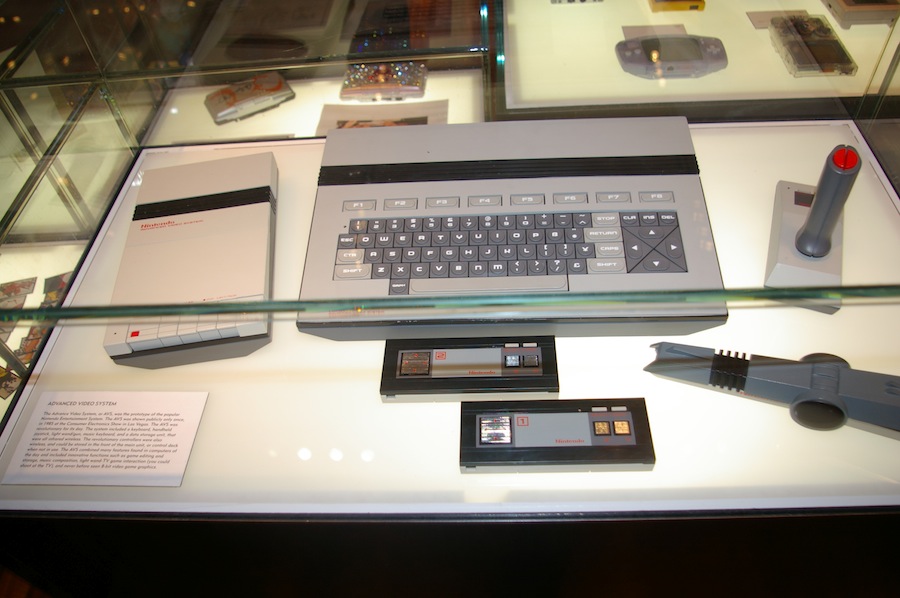
Nintendo’s entrance into the U.S. console/toy market was a phenomenal mixture of marketing and miracle. Atari’s sharp decline in the 1980s was thought to be a bellwether for the collapse of the entire videogame industry. Toy stores were filled with cut-rate carts they couldn’t sell. Atari bet big and lost on rushed blockbusters like Pac-Man and E.T. The future of dedicated videogame hardware was dire.
Meanwhile in Japan, Nintendo had a runaway success with the Famicom. They bet big and won on an unprecedented manufacturing deal. They partnered with chip manufacturer Ricoh to produce the Famicom’s CPU at a bargain price in exchange for a guaranteed 3 million unit order. Nintendo even weathered a disastrous flaw in the Famicom’s initial manufacturing run, leading to an expensive recall and repair program. Yet the Famicom was cheap and technically impressive.
And it could play Donkey Kong.
Analysts warned that Nintendo’s entry into the U.S. market would be catastrophic, especially since they were a Japanese company. (Keep in mind that US/Japan relations were only a generation removed from World War II.) But Nintendo’s tenacious president, Hiroshi Yamauchi, was undaunted. He knew Nintendo’s worldwide success relied on the American market. It turns out he was right — history has justified his instincts by the billions.
Recently, I spent a few hours trawling through Nintendo’s U.S. patents from the 1980s (via Google Patents) and found a remarkable technological history buried within pages of formal legal-speak. Not only do you see the unique console and cartridge designs customized for risky Western markets, but a number of anti-piracy measures (both hardware and software), discarded products (the U.S. Disk System), and design innovations (the D-pad). This article will review a few of the more notable examples.
The D-Pad
Nintendo is never above mining their own history for future products: Donkey Kong arcade units were reworked from unsold Radar Scope boards, the clunky 3D of the Virtual Boy has resurfaced in the (clunky?) Nintendo 3DS, and Mario has worked in professions ranging from doctor to boxing referee. In many cases, Nintendo is willing to work on a novel design until they get it right. Often their best products are hybrids of previous failed or underdeveloped experiments.
The Game + Watch was not a failure (quite the contrary), but its design innovations certainly deserved to live beyond a simple LCD toy. Nintendo’s patent for the ‘Multi-Directional Switch’ illustrates the eponymous device as a component of the Game + Watch, but it reached iconic status as the ‘D-pad’ (‘D’ for digital, not a shape reference) on the Famicom / NES controller.
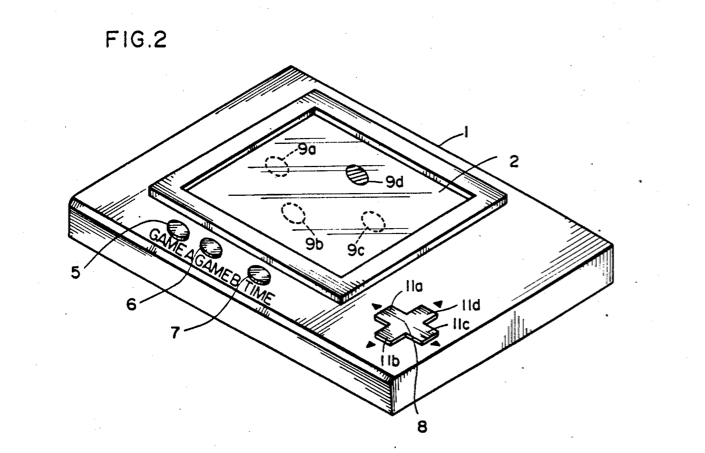
The D-pad movement design is so simple, it seems self-evident, but no joystick designer at that point had really cracked the problem as well as Nintendo. Atari arguably de-volved from the iconic VCS/2600 joystick to the cranky 5200 controller. The Intellivision and ColecoVision fared worse, looking more like aborted cellphone designs than actual usable controllers. These and others were influenced more by arcade or PC controls. More importantly, they dictated a particular range of play options.
In the patent’s ‘Background’ section, it’s evident that Nintendo was really thinking through a usability problem:
In using conventional character moving switches, there is a disadvantage that either variety of a game or simplicity in operation be disregarded.
If, for instance, you limit a game’s input to a single button, it may be simple for the user, but potentially boring to play. If you increase the inputs by assigning buttons to all possible character movements, you suddenly have a control monstrosity. Too many buttons limits both hardware and game design. If buttons are packed too tight, Nintendo rightly asserts, you will ‘encounter another problem in that two or more than two character moving switches are often pressed simultaneously.’ However, leaving adequate space between buttons yields another compromise: ‘the content of a game organized in the liquid crystal display has to be limited.’
In their summary, Nintendo offers the D-pad as a solution:
A primary object of the present invention is to provide a multi-directional switch which can be operated with efficiency in a simplified manner and does not occupy much space for fixing.
It’s an elegant design for the cramped body of a portable system, but it has important repercussions for Nintendo’s later console as well. Though the Famicom initially launched with rehashed ports of popular arcade games, the flagship titles from the 8-bit era are platformers: Super Mario Bros., Contra, Mega Man, Duck Tales, Castlevania, Kirby’s Adventure. The trope of the platform game is movement through 2D space, i.e., running and jumping along horizontal and vertical axes. The D-pad is the ideal hardware for this type of movement. It fits comfortably under a single thumb, freeing the right hand to control the action buttons. Until the advent of 3D space in videogames, the D-pad was the de facto method of character control.
The Front Loader
Part of the NES’s ‘toaster’ moniker came from its unique front-loading design. In most prior cartridge-based consoles, the game was loaded vertically, typically by forcing the cartridge into an exposed slot. Nintendo used this conventional design for the Famicom. However, part of their U.S. strategy was hiding the gaming aspects of their ‘entertainment system.’ Presumably, a cartridge protruding from the top of an appliance screamed ‘VIDEOGAME!’, so Nintendo had to devise an alternative that literally hid the cartridge from view.
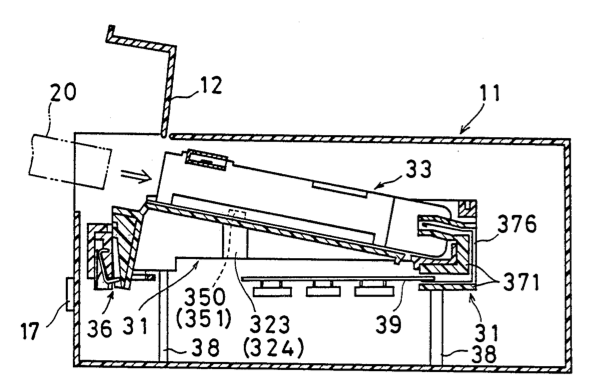
Their design is revealed in the eloquently-titled patent, ‘Front Loading Apparatus for a Memory Cartridge Utilized for a Data Processing Machine’. It was designed to be ‘novel’ and it definitely succeeded on that account. You flipped the hatch on the front of the NES, held the cartridge by its handy ridged grip, forced it horizontally into the console until you met resistance, then pushed it down into the recesses of the machine. Nintendo claimed that this solved a number of problems: it protected the circuit board from ‘spurious radiation,’ it minimized ‘the abrasion of the connecting electrodes of the circuit board of the memory cartridge,’ and, tellingly, required less force for a small child to operate. (Not a toy, though!)
The patent describes the design as such:
The apparatus includes a tray for holding the cartridge and a frame to which the tray is pivotally mounted. The tray is mounted to permit rotation between a cartridge loading position and a cartridge operating position and is biased toward the loading position by a spring means. Also included is a low insertion force connector mounted to the frame for electrically interconnecting the cartridge circuit board to a second circuit board mounted in the data processing machine. Finally, a releasable locking mechanism for retaining the tray in the operating position is provided.
A clever design, but note the ‘spring means.’ Nintendo’s desire to solve a number of reasonable design problems led to a flawed mechanism that ultimately caused more issues than it solved. Perhaps Nintendo underestimated the raw strength of American children, but there was certainly no lack of force for slamming carts into the NES. The delicate spring mechanisms either gave way over time or enabled too much circuit board contact. The 72-pin connector would bend, deteriorate, or corrode over time, leading to the NES’s infamous blinking screens or garbled graphics. Children and adults alike invented ad hoc DIY incantations to ‘fix’ the machine: blowing onto cartridges (moisture and circuits don’t go well together, it seems), sliding the cart in just so, or giving the console a few well-considered pops, like an old tube TV set.
Nintendo’s miscalculated engineering unwittingly became part of the mythology and folklore of the NES.
The Disk System
As the Famicom gained success and games became increasingly complex, programmers soon ran up against the console’s limitations. Lengthier games required multiple sessions to complete, so how do you save a player’s progress? Passwords worked, but they were either a) easily ‘reverse engineered’ by industrious players (e.g., Mega Man 2) or b) overly complex and difficult to type in symbol by symbol (e.g., Metroid). Likewise, there often simply wasn’t enough ROM space to accomodate complex game worlds.
One of Nintendo’s solutions was the Famicom Disk System (FDS), which never saw release outside of Japan. In theory, disk-based media was ideal: it was (re-)writable and more expansive. In practice, the ease of copying data led to rampant game piracy.
Not that Nintendo didn’t plan ahead. The Famicom disks were weird — typically bright yellow, smaller than a standard 3.25″ floppy, and engraved with the corporate name. These material oddities were not mere ornamentation. The proprietary size and embossing were meant to thwart software pirates. And since we have a record of a U.S.-filed patent for the disks, we can presume that Nintendo meant to bring the FDS stateside. But the anti-piracy precautions didn’t work.

As Nintendo explains, the ‘NINTENDO’ lettering was meant to act as a physical deterrent to copying, since the FDS would only accept disks with the proper holes:
When the recordable data device is loaded into the disk drive device, the recessed embossment of the identifying symbol of the magnetic disk is fitted into the projected embossment of the identifying symbol of the magnetic disk drive device. If the data recording device is authentic, the data processing system allows the disk drive device to [sic] data to or read data from the magnetic disk. If the embossed identifying symbols do not fit, the floppy disk, that is, the recordable data device, is rejected as not authentic and data-writing or data reading is prevented.
Nintendo claimed that standard disks allowed the illegal reproduction of their software, which could flood the market with low-cost copies, damaging Nintendo and its suppliers, and confuse consumers about which games were authentically made by Nintendo. So they devised a material solution to a software problem: ‘the data recording device can be authenticated by its structure or form.’ This is similar to the tactics used in the early PC gaming industry, where special code wheels or printed manuals were necessary to unlock their software. But Nintendo carved the means of copyright protection on the media itself.
Of course, pirates will find a way. Third parties discovered that they could mimic the recessed Nintendo name with spelling variations or just a few properly positioned holes. (The Famicom Disk System site has a fantastic gallery of legitimate and illegitimate FDS disks.)

Sadly, the FDS, like the NES, was also plagued by mechanical defects. Its drive belts were flimsy and prone to break. The unconventional disk design left part of the disk exposed, so it could be easily damaged. The disk drive often malfunctioned and flipping disks mid-game was no fun. As a result, Nintendo abandoned the American FDS and opted to solve cart memory limitations (and copyright circumvention) through other means.
The MMC
Nintendo’s original cartridge space was scant by today’s standards. The NROM-128 (‘Nintendo ROM’) had a mere 24 KiB of memory, split between 16 KiB of PRG-ROM (‘program ROM,’ where the code was stored) and 8 KiB of CHR-ROM (‘character ROM,’ where the ‘characters,’ or graphics, were stored). These constrained specs sufficed for Nintendo’s first round of games, typically arcade ports (e.g., BurgerTime and Mario Bros.) with rudimentary gameplay mechanics, simplistic graphics, and limited (if any) scrolling. A later configuration, the NROM-256, bumped the PRG-ROM to 32 KiB. This expanded board saw its share of arcade ports, but it also housed one of the most remarkable games to date, Super Mario Bros.
SMB opened the floodgates for more sophisticated gameworlds, free from the quarter-driven strictures of arcade games. Its progressive stages, end-world bosses, hidden items, and rudimentary narrative rewarded sustained play in longer sessions. But its complexity also pushed the limits of the NES cartridge hardware. Programmers needed more room to develop the types of experiences that gamers now demanded.
The floppy disc was one (failed) option. The MMC, or memory-mapped controller, was another.
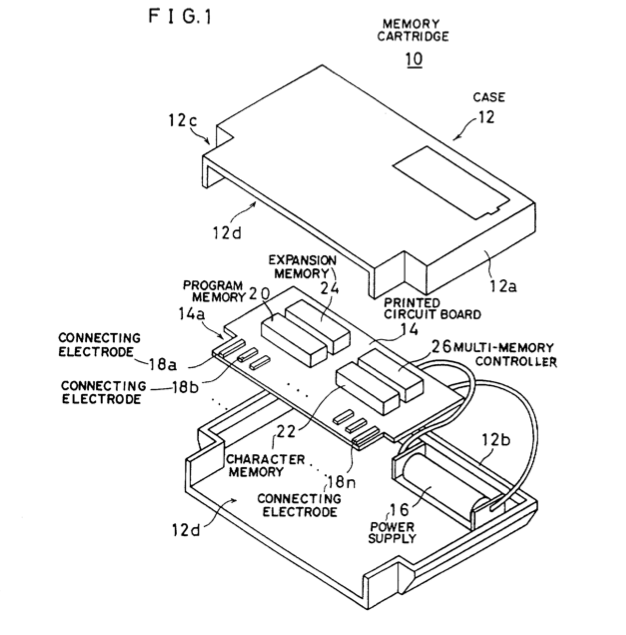
Nintendo’s 1990 patent describes the MMC’s function:
A multi-memory controller installed on the printed circuit board includes a plurality of registers into which microprocessor generated data, representing bank switching conditions, are loaded. An address for switching the memory banks is output in response to the content of at least one of a plurality of registers. Thus, by changing the above-described data, the microprocessor can specify a specific bank at a specific time and utilize that bank.
Got all that? It’s not terribly complex once you understand the basics of how the NES worked. Programs of this era were coded in assembly language, one abstraction step above raw machine language. Assembly is essentially a series of shorthand instructions followed by either a) an address or b) some data. The NES CPU had a number of registers, essentially hard-coded addresses where data could be stored, replaced, and transferred. The system is similar to a post office with thousands of individual numbered boxes. If I want my letter from Richmond, Virginia to arrive in Spokane, Washington, I might send my ‘data’ via box #2007. The reply back might come via box #4001. Thus, if the NES CPU needed to communicate with the separate PPU (the ‘picture processing unit’ that handled getting graphics on-screen), it had to send bytes of data to the proper register address. However, the CPU’s address space was limited. Even though a cartridge might have vast amounts of data to send, the CPU might not be able to ‘see’ it all.
The technique used by the MMC is called ‘bank-switching.’ It allows the CPU to see more data by pulling a little switcheroo behind the scenes, so to speak. The cartridge might have 64 KiB of possible PRG-ROM space split into four individual ‘banks’ of 16 KiB a piece. By passing a command to a specific swapping register, banks could swap in and out, permitting access to more program space, RAM, character ROM, and so on. Thus the name MMC — it was a hardware controller that mapped additional memory.
There were a wide variety of MMCs, which grew in size and speciality, permitting the NES to work beyond its initial limitations. Later Nintendo MMCs like MMC3 and MMC5 added handy features like scanline counting for precise timed code (useful for split-screen effects) and up to 1024 KiB of PRG-ROM. Third-party mappers like Konami’s VRC7 even added additional sound channels, as heard in the remarkable music of Famicon-only title Lagrange Point.
In short, without the cart-juicing effects of the MMC, we never would’ve seen games like Mega Man 2, Castlevania III, Battletoads, or Super Mario Bros. 3 on the NES.
The Lockout Chip
After the FDS piracy problems in Japan, Nintendo knew they needed a better solution for the Western market. Enter the infamous ‘lockout chip.’
Nintendo’s patent for the ‘Computer Game Cartridge Security Circuit’ describes a combined hardware/software solution to piracy. All game carts would perform an electronic handshake with the console to make sure it was authorized to play:
It has been found that a Nintendo brand game console periodically cycles between active and inactive states while waiting for the proper signals from the game cartridge in order to authenticate it. The game cartridge security circuit of the present invention monitors that activity through address lines to the cartridge ROM and causes a series of pulses to commence substantially immediately upon it being sensed that the host game console has transitioned from an inactive to an active state.
If the authenticating signal was absent (e.g., an unlicensed cartridge), the console would go into a reset cycle loop. Sound familiar? True to form, Nintendo’s anti-piracy engineering blocked many legitimate carts as well. If the cart had a faulty lockout chip or didn’t have a tight connection to the console (see: ‘The Front Loader’ above), your console would blink on and off in one second intervals. Many a sleepover was ruined in the 1980s by the cursed blinking screen.
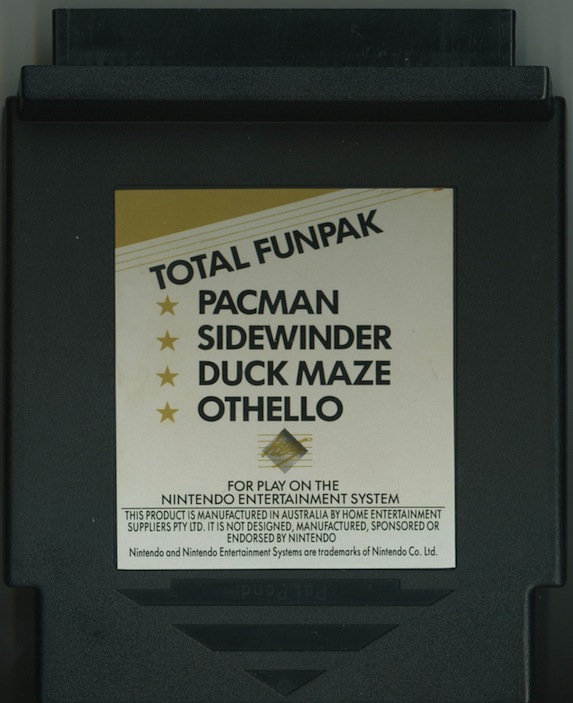
Unlicensed companies found ways to circumvent the chip, through both electrical and social engineering. Camerica’s carts, for instance, sent a voltage spike to the lockout chip, disabling it long enough to have the cart run. The Australian-based HES built awkward dongle-based solutions that piggy-backed on licensed NES carts in order to backdoor the system. Tengen was the most brazen: they contacted the US Patent and Trademark Office under false legal pretenses, claiming that they needed access to the lockout chip’s source code. Tengen built their own clone (and got sued by Nintendo). Today, homebrew manufacturer Retrozone sells a Ciclone chip that is a reverse-engineered clone of the Tengen chip.
The Grey Cart
Ever spot those oddball powder blue or black NES carts in the wild? And notice how they weren’t shaped quite the same? As a kid, I only came across a few of these and I was surprised to find they actually worked in a Nintendo console. As far as I knew, an NES cartridge was gray with a notched portion to grip and weird ridges along a narrow vertical strip. And that’s exactly what Nintendo wanted me to think.
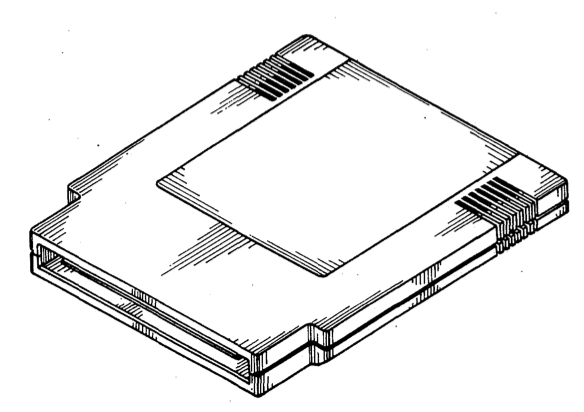
Nintendo owned the patent on that unique cartridge shape, partly for branding and partly to control all aspects of Nintendo’s licensing and manufacturing process. There were strict regulations governing any company that wanted a game on the NES and Nintendo went to Apple-like lengths to maintain the sanctity of their walled garden. They were determined to avoid the catastrophe of quality control that sent Atari to a quick and disastrous demise.

Of course, once third parties figured out how to circumvent the NES lockout chip, the walls came down. Thankfully, this didn’t lead to a second videogame crash, but it did lead to some bizarre riffs on the NES cartridge design that would still fit in the console, but not infringe Nintendo’s patent. Tengen fared the best on this account — their svelte black carts were stylish (though not exactly practical).
Still, the boxy blue Color Dreams carts had their charm. PRESS HERE.
Additional Resources
This small sample of patents is only part of the story, but it provides a glimpse into Nintendo’s hardware history — a history tied to social, cultural, and economic considerations. If Nintendo hadn’t shrewdly made the NES less toy-like, we might have a vastly different console landscape. They may have disappeared altogether. And Mario might have remained a Japanese cultural oddity, rather than a worldwide brand-leading monolith.
If you’re interested in delving further into the action-packed world of patent research, I’ve provided a few more NES-related links. Of course, it’s not hard to search for these on your own. The PDFs are easily accessible from Google Patents. Enjoy:
- Power Glove, or ‘Forearm mounted multi-axis remote control unit’
- R.O.B., or ‘Game robot’
- NES Four Score, or ‘Multi-user adaptor for a video game’
- Hands-free controller (for disabled gamers)
- NES cart cleaner (no more blowing on carts!)